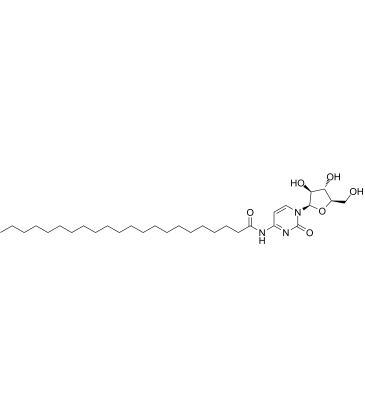55726-47-1
| Name | Enocitabine |
|---|---|
| Synonyms |
1-(β-D-Arabinofuranosyl)-4-(docosanoylamino)pyrimidin-2(1H)-one
ENOCITABINE ANTINEOPLASTIC DRUGS N(4)-Behenoyl-1-b-D-arabinofuranosylcytosine BH-AC n(sup4)-behenoylcytosinearabinoside 1-(β-D-Arabinofuranosyl)-4-(docosanoylamino)-2(1H)-pyrimidinone BEHENOYLCYTOSINE ARABINOSIDE MFCD00866294 Docosanamide, N-(1-β-D-arabinofuranosyl-1,2-dihydro-2-oxo-4-pyrimidinyl)- Enocitabine Sunrabin 2(1H)-Pyrimidinone, 1-β-D-arabinofuranosyl-4-[(1-oxodocosyl)amino]- N-(1-b-D-Arabinofuranosyl-1,2-dihydro-2-oxo-4-pyrimidinyl)docosanamide Enocitabine [INN:JAN] N4-Behenoylcytosine arabinoside |
| Description | Enocitabine, a nucleoside analog, is a potent DNA replication inhibitor and a DNA chain terminator. Enocitabine can be used as an effective chemotherapeutic agent for the treatment of acute myelogenous leukaemia and lymphocytic leukaemias[1]. |
|---|---|
| Related Catalog | |
| Target |
DNA replication[1]; CMV[3] |
| In Vitro | Enocitabine is resistant to deamination because Enocitabine bears a highly lipophilic group at the 4-amino position of the cytosine moiety of cytarabine[1]. The combined effects of Pirarubicin and Enocitabine on HeLa S3 human uterine cervix carcinoma and K562 human myelocytic leukemia cells are determined by enhancement of their cytotoxic activities. Enocitabine or etoposide shows synergistic effects on HeLa S3 and K562 cells[2]. In the presence of Enocitabine, triphosphate forms of the nucleoside analogs are detected in the human cytomegalovirus (HCMV)-infected cells, and synthesis of HCMV DNA is strongly suppressed[3]. |
| References |
| Density | 1.2±0.1 g/cm3 |
|---|---|
| Melting Point | 141-142ºC |
| Molecular Formula | C31H55N3O6 |
| Molecular Weight | 565.785 |
| Exact Mass | 565.409058 |
| PSA | 133.91000 |
| LogP | 9.00 |
| Index of Refraction | 1.554 |
| Storage condition | -20°C Freezer |
CHEMICAL IDENTIFICATION
HEALTH HAZARD DATAACUTE TOXICITY DATA
|
| Hazard Codes | Xi |
|---|
